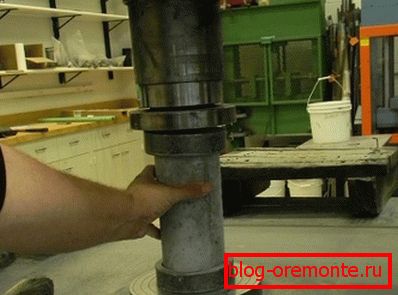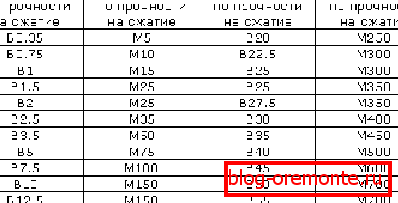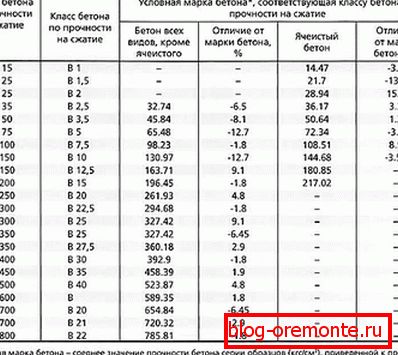Class of concrete and its grade in compressive strength,
Since hardened concrete contains components that are heterogeneous in nature, it is a conglomerate (composite type) material. Therefore, one of the main properties by which it is possible to determine whether it is of high quality can be called adhesion. This article will talk about what a class of concrete is, as well as touch on other material characteristics.

Quality of material
Under the adhesion refers to how well the cement stone is held together with particles of aggregates. In addition, the main qualities can also include:
- frost resistance;
- water tightness;
- compressive and tensile strength.
When the material is at the project age, its strength characteristics can be judged by the last parameters. Therefore, it is worth noting that during cooking it turns out heterogeneous.

The fluctuations in strength are reduced with the high-quality preparation of the mixture, as well as with a higher construction culture. Therefore, it is worth remembering that the fabricated material should not only have an average specified value, but also have its uniform distribution over the entire surface.
Class definition
Consider the above fluctuations can be in such an indicator as a class, which is understood as the percentage indicator of a property. For example, if it is indicated that the material has a strength class of 0.95, then in 95 cases and 100 it will have such an indicator.
It should be noted that according to GOST, the classification of concrete consists of 18 main classes of indicators of compressive strength. In this case, at the beginning of the class name is indicated B1, followed by the numerical value of the tensile strength, displayed in MPa.

For a more accurate perception, it is worth giving an example. So, suppose that we face class B35. This means that in 95 cases out of 100 it provides a ultimate compressive strength of up to 35 MPa.
In addition, there are other strength classes:
- index B ,, denotes axial tension;
- Btb index displays the limit of stretching when bending.
Remember that the compressive strength can be 20 times higher than the same value of tensile strength. Therefore, the construction is used steel reinforcement, which increases the load-bearing capacity of the material, the price increases.

Brand definition
According to the standard CMEA 1406-78, the main indicator of the strength of products is their class. If during the design of various products this standard was not taken into account, their strength is described using a brand.
Under it understand any of its property, expressed in numerical characteristics, for the calculation of which the average results of the samples shown during the tests are used. To designate the brand use the values obtained during the test:
| Minimum | It is used if it is determined by such indicators as: · water tightness; · cold resistance; · Strength. |
| Maximum | It is used in the determination of concrete by the average density. |
Tip: Be aware that brand relief cannot display strength variations over the entire volume of a concrete product.

Brand for compressive strength
- This is one of the most commonly used characteristics of concrete structures.
- The instruction requires for its determination to use samples in the form of a cube, having a length of 150 mm on one side.
- The test is conducted during the nominal design age - in most cases it is 4 weeks.
Tip: if a series of three samples is taken, the ultimate strength is calculated from the two largest ones. For its expression such units are used - kgf / cm2.
- Experts allocate only 17 grades of heavy concrete depending on its compressive strength. For their designation is used the index "M", after which the number is indicated. For example, the M450 brand means that such concrete guarantees a minimum compressive strength of 450 kgf / cm.2.
- If we take into account the strength of axial tension, then its marks are much more - from Pt5 to Pt50 (each time adding 5 kgf / cm2). For example, the grade of concrete Pt30 will mean that it is able to withstand axial tension up to 30 kgf / cm2.
- For concrete, which will be used during the manufacture of bent concrete structures, there is also a flexural tensile characteristic, which is displayed using the “Ptb” index.
Tip: it is not always necessary to draw parallels between the concrete grade and its class.

Classes and brands
The fact is that a lot depends on how homogeneous the material is. To denote this value, the coefficient of variation is used.
The lower its numerical value, the more homogeneous concrete has. With a decrease in this indicator, the class and grade of material, respectively, decrease. For example, the M300, which has a variation coefficient of 18%, will receive a class B15, while a decrease to a value of 5% will increase the class to B20.
Tip: the research results prove that during the manufacture of concrete mix it is necessary to achieve its maximum homogeneity.
Many factors influence the numerical value of strength. The greatest is the quality of the initial components, as well as such an indicator as porosity.

To set the strength of a material made using Portland cement, a considerable amount of time is required. In addition, for the normal course of the process requires compliance with certain conditions.
Frost resistance
Using such an indicator as a brand of frost resistance of concrete, you can determine how many freezing and thawing cycles can withstand a 28-day material, losing no more than 15% of the compressive strength index. To indicate such an indicator, the index F is used, and there are altogether 11 classes.
Advice: for concrete to have good frost-resistant properties, it should include high-quality portland cement, as well as its various modifications - sulfate-resistant, hydrophobic, etc.
However, there are certain limitations on the percentage content of tricalcium aluminate in Portland cement.
For example, for:
- F200 is allowed no more than 7% of such a substance;
- F300 - up to 5%, etc.
The presence of active mineral additives in cement is extremely undesirable, as the use of water increases as a result of their use. But the reduction of water demand is achieved through the use of surfactants.

Tip: in hydraulic structures with a frost resistance grade of F 300, as well as aggregate with a diameter of not more than 20 mm, the volume of entrained air should be within 2-4%
Here is a quick guide to follow:
- To obtain high-quality frost-resistant concrete, the most accurate ratio of all components must be observed.
- They must be thoroughly mixed with your own hands, getting the most homogeneous mixture.
- After this condense.
- Provide the necessary good conditions during the hardening process.
Tip: make sure that there is no thermal expansion of the constituents of concrete, and the value of water and air were within acceptable limits.
In situations where the manufacture of parts with a high degree of frost resistance (F200 and above) is carried out, it is worth remembering that the material must harden in conditions of a positive ambient temperature. In addition, its humidity should be maintained for about 10 days.
Permeability
The mark for such an indicator as water tightness is determined by material testing for limited permeability during one-sided water pressure. For its designation use the index "W", followed by a number.

It indicates the maximum pressure (in kgf / cm2), which can withstand the sample, the diameter and height of which is 150 mm, during certain tests. For example, Mark W4 withstands water pressure at 4 kgf / cm2. In total there are 10 brands - from W2 to W20 (adding 2 kgf / cm2).
There are methods by which you can increase the watertightness of the mixture during its preparation, laying and hardening of concrete, as well as methods that can increase this figure is already hardened material.
Conclusion
This article has been told about the classes and grades of concrete, which are read important indicators. They enable the correct selection of material for repair and construction work. You also learned GOST on the class of concrete and indexes that designate it and the brand. The video in this article will help you find additional information on this topic.